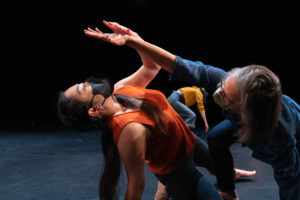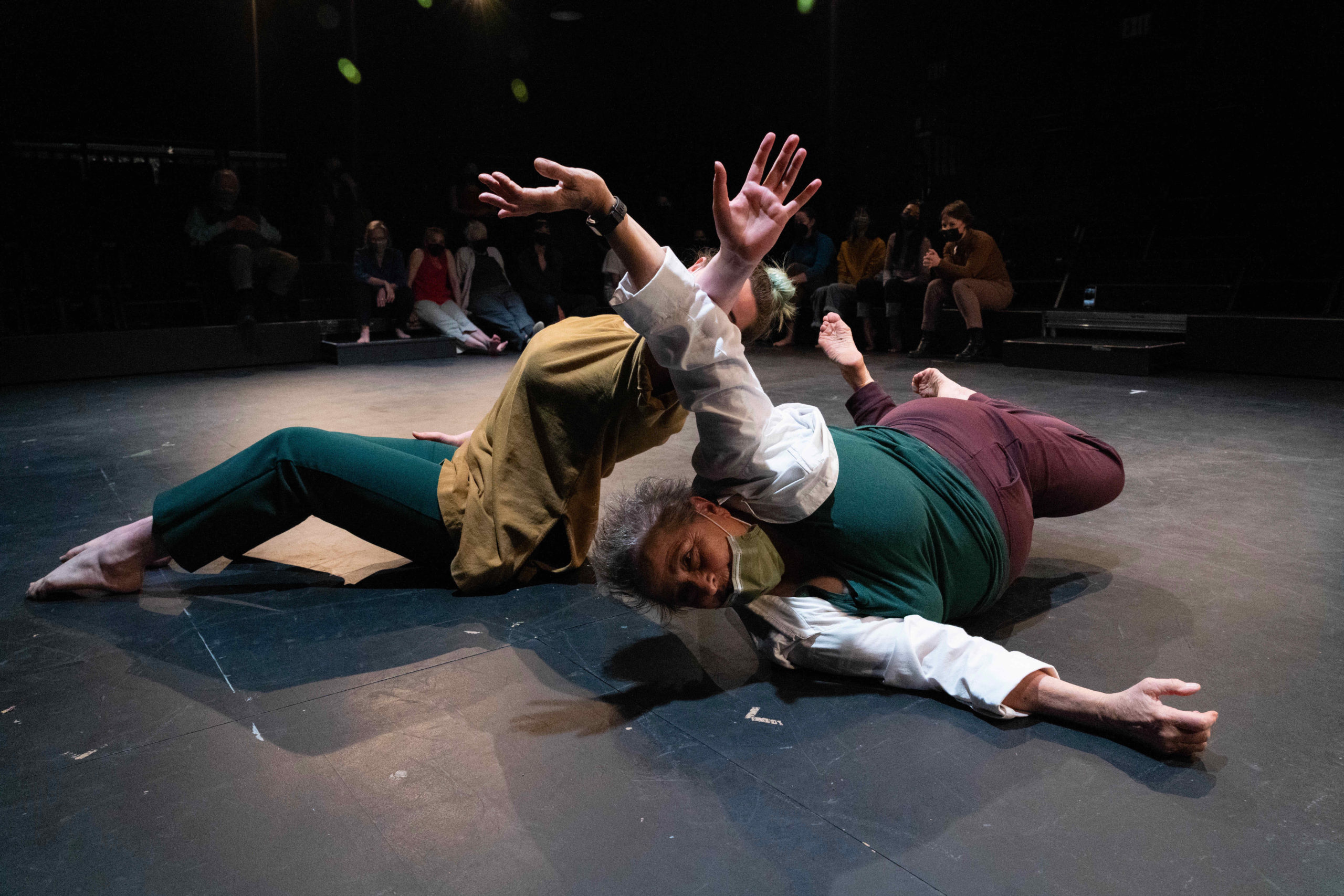Photo by Hillary Goidell
[ID: Raychel, a 20 year old biracial woman, sits on the floor and leans back as Ann, a 73 year old white woman lays on her side next to her. Both are wearing rich greens and purple and are reaching skywards, crossing arms at USF. A group is watching lovingly from behind, nearly in darkness.]
I recently met Ellen Webb when a colleague informed me that she owned a dance studio for rent insanely close to my West Oakland home. I had never heard of her, but arrived at a hidden backyard studio space that was adorned with faded posters illustrating her successful performances across the United States and Europe in the 1980s and ‘90s. I was intrigued by the fragility of it all; she seemed to have made it, but does her story sit in the background of the current Bay Area dance scene? “It was okay to do it, and okay not to do it,” remarked Ellen, speaking on her time during and post her dance career. “It’s a challenging thing for dancers – or it was for me…At one point, it just ends.”
“She’s a legend!” I thought to myself. I felt naive for not knowing about her.
Since 2018, I’ve focused my creative research on aging and intergenerational dance practices. When people of different ages dance together, they unlearn the biases they previously had. They commit to authentic responsiveness within physical and creative interactions between one another. There’s a visceral sense for what it’s like to cultivate belonging across divides. Experiencing belonging within a group of varied bodies and abilities exposes ageist and ableist ideals in the dance field, and teaches skills for dancing with an inclusive quality and spirit that challenges conventional notions of who is valued as a dancer. Thus, when we dance our values, intergenerational dance itself becomes activism, versus choreographing a piece about ageism.

For me, it’s the multidirectionality that I’m drawn to most when working across generations. There is, of course, the to-be-expected passing down of anecdotes from older adults to youth, accompanied by youth driven surges of energy and excitement. And through dance that script gets flipped: Youths are natural leaders and teachers, and older adults allow their innovation and playfulness to gush from behind mountains of “the way things always were,” like a flowing river that has been greatly anticipating the opportunity. There’s permission to evolve from the way things were, and to reimagine how things might be – for everyone.
I also think there’s deep learning about power and obedience in the dance studio. A reminder to get curious about a tradition if it’s no longer serving you. A gentle challenge to the idea of one sole teacher, choreographer, or director at the front of the room. Like many forms of dance, dancing across generations works best in a circle versus in lines facing towards mirrors. I see it as a representation of the reality that time is nonlinear. The circle can be time’s equalizer, with a sense of all ages reflected in and around us, happening all at once.
Celeste Miller, a linguistics-fascinated mentor and friend of mine, once shared that in English, as in many languages, we orient ourselves to the past as something behind us, and the future as what’s in front of us or ahead. Some Arabic speakers, however, conceptualize the past as in front of us because we can see it and the future behind us, a mystery yet to be seen. The movement vocabulary, and thus language of intergenerational dance, allows us to grasp the complexity of looking backwards and forwards in time simultaneously.
When I watch a cast of age-homogeneous performers, time stands still. There is a deep sense of uniformity and attunement among them. For a moment, I am suspended in their world and my own falls away. Satisfying. With an intergenerational cast, time moves in all directions. Past and future selves churning through time: generational time, time left to live, and time beyond our lives. I am not suspended in the performer’s world of attunement, but instead sensing all of time, leaving me suspended in my own personal present.

To see an older body beside a younger body in performance is to face our own inevitable decline. And for me, it triggers some heart-wrenched urgency to seize each moment. I adore the way that aging bodies –something we societally associate with slowing down, declining health and frailty–can be a catalyst for increased speed towards our own vitality and thriving. I love the duality present in aging’s reminders that none of this (life) matters, because none of us are getting out of this alive, but then very much simultaneously – holy shit, everything is sacred. Death is a choreographer, and she’s commissioning all of us to let go enough to tumble through time – rhythmically, chaotically, and inevitably – while also preserving enough care and awareness to sanctify each ordinary moment.
I recently met Bill Haskell, age 77; the man responsible for overseeing the creation of the first AIDS hospice in the United States, in the mid-1980s, right here in San Francisco. We spoke on record for StoryCorps as board members of San Francisco Village. Bill worked with the San Francisco Department of Public Health, participating in the development of the AIDS model, a model that increased access and quality of long-term care services and support for people with HIV/AIDS. Before he retired, he worked on developing long-term care and supportive services for all older adults and adults with disabilities in the San Francisco Bay Area.

I was stunned by the breadth of his work and the impact his work made both locally and globally. My mind and heart flutter between honoring his heroic past and dreaming about what could remain undiscovered in his future. I wonder what responsibility dance has to tell the stories of the legends who shaped our world, who saved our world. Legends who walk among us.
Bill’s work has that same sense of past-future duality and intergenerational multidirectionality I mentioned earlier. He sat with illness, death, and destruction of a community while also innovating new pathways for progress in long-term care.
I feel strongly that the ephemeral nature of dance is a rich training ground for acceptance of this kind of duality, and of our own temporality. Think about it: we rehearse for months or years for maybe a few weekends of performances that seem to fly by, and then dissipate the moment that final curtain closes. If we could view dance practice as death practice, would society find greater value in funding the arts? Would we feel more ready when things, personally or professionally, inevitably come to an end?
I remember asking Margaret Jenkins about what’s next for her at this stage in her career. “My next piece, Global Moves, might be my last piece making work in this way, so it’s a death of a kind,” she told me over coffee. “But the process constantly informs…and continuing albeit differently, is a necessity!”
I wonder what it’s like to make something with the awareness of knowing it may be the last of its kind that you make. I wonder if as artists we got lucky with the ability to constantly evolve our processes as a way to outrun any chance at expiration – like a superpower of immortality that being a creative awards us. I wonder if it’s possible to feel like a legend, not for what you’ve done, but for who you are now.
Perhaps creating space for older adult artists’ voices is just a way to guarantee that I’ll have belonging in this field as I age, too. Perhaps it’s a way to try and live forever, despite my soap box for mortality.
Right around the time I was writing this article, the University of San Francisco welcomed students back to campus for the start of the Fall semester. I was introduced to fresh faces, mostly 17 – 22 years-old, studying dance, theater, music, nursing, computer science, business, and engineering in my course on community engaged dance pedagogy. They seemed like a special bunch – vibrantly interested in learning new dances and connecting more deeply to their own communities. They are playful, passionate, and curious upon first impressions. “Hi & Welcome!” I beam with gusto from the front of the lecture hall, daydreaming about what their futures might entail. I smile at their hidden beauty and think to myself, “Legends walk among us.”
This article appeared in the Fall 2022 issue of In Dance.


